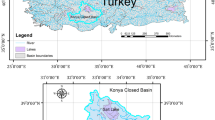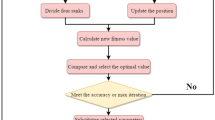Abstract
Considering the limited accuracy of classical empirical formulas and traditional Machine Learning (ML) models for predicting the depth-averaged velocity of flow through submerged vegetation, in this article, a novel hybrid ML model named BO-LSSVM is developed that incorporates Bayesian Optimization (BO) into Least Squares Support Vector Machine (LSSVM). Comparing with standalone LSSVM, BO helps LSSVM to find the optimal hyperparameter combination and thus promotes its prediction accuracy. To further enhance the prediction performance, two different preprocessing methods including nondimensionalization and standardization are adopted to process the input parameters with nondimensionalization observed that better improves the performance of the ML predictions. Furthermore, comparisons with the other frequently used ML models (i.e., standalone LSSVM, Support Vector Machine (SVM) and Multilayer Perceptron (MLP)) and the previously proposed empirical formulas are also carried out. Best performance of BO-LSSVM with RMSE of 0.0188 and MAE of 0.0128 indicates its superiority when dealing with the prediction of the depth-averaged velocity. Besides, the highest prediction reliability of BO-LSSVM is further emphasized in the uncertainty analysis with uncertainty bandwidth of 0.008. Lastly, sensitivity analysis is conducted to figure out the relative importance of the involved input parameters, which turns out that the parameters about the frictional resistance demonstrate relatively higher importance than those regarding the bed slope.






Similar content being viewed by others
Data Availability
The data presented in this study is available on request from the corresponding author.
References
Akbari M, Salmasi F, Arvanaghi H, Karbasi M, Farsadizadeh D (2019) Application of Gaussian process regression model to predict discharge coefficient of Gated Piano Key Weir. Water Resour Manage 33:3929–3947
Alruqi M, Sharma P, Deepanraj B, Shaik F (2023) Renewable energy approach towards powering the CI engine with ternary blends of algal biodiesel-diesel-diethyl ether: Bayesian optimized Gaussian process regression for modeling-optimization. Fuel 334:126827
Ansari MF, Hussain A, Ahmad Ansari M (2021) Experimental studies and model development of flow over Arched Labyrinth Weirs using GMDH method. J Appl Water Eng Res 9:265–276
Bafitlhile TM, Li Z (2019) Applicability of ε-support vector machine and artificial neural network for flood forecasting in humid, semi-humid and semi-arid basins in China. Water 11(1):85
Baptist MJ, Babovic V, Rodríguez Uthurburu J, Keijzer M, Uittenbogaard RE, Mynett A, Verwey A (2007) On inducing equations for vegetation resistance. J Hydraul Res 45:435–450
Bonakdari H, Azimi H, Ebtehaj I, Gharabaghi B, Jamali A, Talesh S (2022) Estimation of velocity field in narrow open channels by a hybrid metaheuristic anfis network. In: Arai K (ed) Intelligent Computing: Proceedings of the 2022 Computing Conference, vol 1. Springer, London, pp 1–24
Bui DT, Pradhan B, Nampak H, Bui QT, Tran QA, Nguyen QP (2016) Hybrid artificial intelligence approach based on neural fuzzy inference model and metaheuristic optimization for flood susceptibilitgy modeling in a high-frequency tropical cyclone area using GIS. J Hydrol 540:317–330
Cheng NS (2011) Representative roughness height of submerged vegetation. Water Resour Res 47(8):W08517
Cheng NS (2015) Single-layer model for average flow velocity with submerged rigid cylinders. J Hydraul Eng 141:06015012
Choubin B, Zehtabian G, Azareh A, Rafiei-Sardooi E, Sajedi-Hosseini F, Kişi Ö (2018) Precipitation forecasting using classification and regression trees (CART) model: a comparative study of different approaches. Environ. Earth Sci. 77:1–13
Dayev ZA (2020) Application of artificial neural networks instead of the orifice plate discharge coefficient. Flow Meas Instrum 71:101674
Deng Y, Zhang D, Zhang D, Wu J, Liu Y (2023) A hybrid ensemble machine learning model for discharge coefficient prediction of side orifices with different shapes. Flow Meas Instrum 91:102372
Huai WX, Zeng YH, Xu ZG, Yang ZH (2009) Three-layer model for vertical velocity distribution in open channel flow with submerged rigid vegetation. Adv Water Resour 32:487–492
Huai WX, Li S, Katul GG, Liu MY, Yang ZH (2021) Flow dynamics and sediment transport in vegetated rivers: A review. J Hydrodyn 33:400–420
Huthoff F, Augustijn DC, Hulscher SJ (2007) Analytical solution of the depth‐averaged flow velocity in case of submerged rigid cylindrical vegetation. Water Resour Res 43(6):W06413
Hu Z, Karami H, Rezaei A, Dadras Ajirlou Y, Piran MJ, Band SS (2021) Using soft computing and machine learning algorithms to predict the discharge coefficient of curved labyrinth overflows. Eng Appl Comp Fluid Mech 15:1002–1015
Khoshkonesh A, Sadeghi SH, Gohari S, Karimpour S, Oodi S, Di Francesco S (2023) Study of dam-break flow over a vegetated channel with and without a drop. Water Resour Manage 37:2107–2123
Kumar B, Patra S, Pandey M (2023) Experimental investigation on flow configuration in flexible and rigid vegetated streams. Water Resour Manage 37:6005–6019
Li S, Shi H, Xiong Z, Huai W, Cheng N (2015) New formulation for the effective relative roughness height of open channel flows with submerged vegetation. Adv Water Resour 86:46–57
Maleki A, Elahi M, Assad MEH, Alhuyi Nazari M, Safdari Shadloo M, Nabipour N (2021) Thermal conductivity modeling of nanofluids with ZnO particles by using approaches based on artificial neural network and MARS. J Therm Anal Calorim 143:4261–4272
Mavrommatis A, Christodoulou G (2022) Comparative experimental study of flow through various types of simulated vegetation. Environ Process 9:33
Meddage DPP, Ekanayake IU, Herath S, Gobirahavan R, Muttil N, Rathnayake U (2022) Predicting bulk average velocity with rigid vegetation in open channels using tree-based machine learning: a novel approach using explainable artificial intelligence. Sensors 22:4398
Muhammad MM, Yusof KW, Mustafa MRU, Zakaria NA, Ab Ghani A (2018) Prediction models for flow resistance in flexible vegetated channels. Int J River Basin Manage 16:427–437
Okhravi S, Schügerl R, Velísková Y (2022) Flow resistance in lowland rivers impacted by distributed aquatic vegetation. Water Resour Manage 36:2257–2273
Papaioannou V, Prinos P (2021) A macroscopic approach for simulating horizontal convection in a vegetated pond. Environ Process 8:199–218
Rapur JS, Tiwari R (2019) Multifault diagnosis of combined hydraulic and mechanical centrifugal pump faults using continuous wavelet transform and support vector machines. J Dyn Syst Meas Control 141(11):111013
Roushangar K, Alami MT, Shiri J, Asl MM (2018) Determining discharge coefficient of labyrinth and arced labyrinth weirs using support vector machine. Hydrol Res 49(3):924–938
Roushangar K, Majedi Asl M, Shahnazi S (2021) Hydraulic performance of PK weirs based on experimental study and kernel-based modeling. Water Resour Manage 35:3571–3592
Seyedzadeh A, Maroufpoor S, Maroufpoor E, Shiri J, Bozorg-Haddad O, Gavazi F (2020) Artificial intelligence approach to estimate discharge of drip tape irrigation based on temperature and pressure. Agric Water Manage 228:105905
Shi H, Liang X, Huai W, Wang Y (2019) Predicting the bulk average velocity of open-channel flow with submerged rigid vegetation. J Hydrol 572:213–225
Stone BM, Shen HT (2002) Hydraulic resistance of flow in channels with cylindrical roughness. J Hydraul Eng 128:500–506
Suykens JA, De Brabanter J, Lukas L, Vandewalle J (2002) Weighted least squares support vector machines: robustness and sparse approximation. Neurocomputing 48:85–105
Tang H, Tian Z, Yan J, Yuan S (2014) Determining drag coefficients and their application in modelling of turbulent flow with submerged vegetation. Adv Water Resour 69:134–145
Tinoco RO, Goldstein EB, Coco G (2015) A data-driven approach to develop physically sound predictors: Application to depth-averaged velocities on flows through submerged arrays of rigid cylinders. Water Resour Res 51(2):1247–1263
Wang Y, Wang H, Peng Z (2021) Rice diseases detection and classification using attention based neural network and bayesian optimization. Expert Syst Appl 178:114770
Yang W, Choi SU (2010) A two-layer approach for depth-limited open-channel flows with submerged vegetation. J Hydraul Res 48:466–475
Yarahmadi MB, Parsaie A, Shafai-Bejestan M, Heydari M, Badzanchin M (2023) Estimation of Manning roughness coefficient in alluvial rivers with bed forms using soft computing models. Water Resour Manage 37:3563–3584
Zhao H, Tang H, Yan J, Liang D, Zheng J (2020) Spectral shortcut in turbulence energy transfer in open channel flow over submerged vegetation. J Hydro-environ Res 33:10–18
Acknowledgements
The authors acknowledge the financial support from the National Natural Science Foundation of China (Grant No. 52179060).
Funding
This work was supported by the National Natural Science Foundation of China (Grant No. 52179060). National Natural Science Foundation of China, 52179060, Yakun Liu.
Author information
Authors and Affiliations
Contributions
Yangyu Deng Methodology, Data analysis, Writing. Yakun Liu Conceptualization, Editing, Funding acquisition.
Corresponding author
Ethics declarations
Ethical Approval
Not applicable.
Consent to Participate
Not applicable.
Consent to Publish
Not applicable.
Competing Interests
The authors have no relevant financial or non-financial interests to disclose.
Additional information
Publisher's Note
Springer Nature remains neutral with regard to jurisdictional claims in published maps and institutional affiliations.
Rights and permissions
Springer Nature or its licensor (e.g. a society or other partner) holds exclusive rights to this article under a publishing agreement with the author(s) or other rightsholder(s); author self-archiving of the accepted manuscript version of this article is solely governed by the terms of such publishing agreement and applicable law.
About this article
Cite this article
Deng, Y., Liu, Y. Prediction of Depth-Averaged Velocity for Flow Though Submerged Vegetation Using Least Squares Support Vector Machine with Bayesian Optimization. Water Resour Manage 38, 1675–1692 (2024). https://doi.org/10.1007/s11269-024-03751-w
Received:
Accepted:
Published:
Issue Date:
DOI: https://doi.org/10.1007/s11269-024-03751-w




